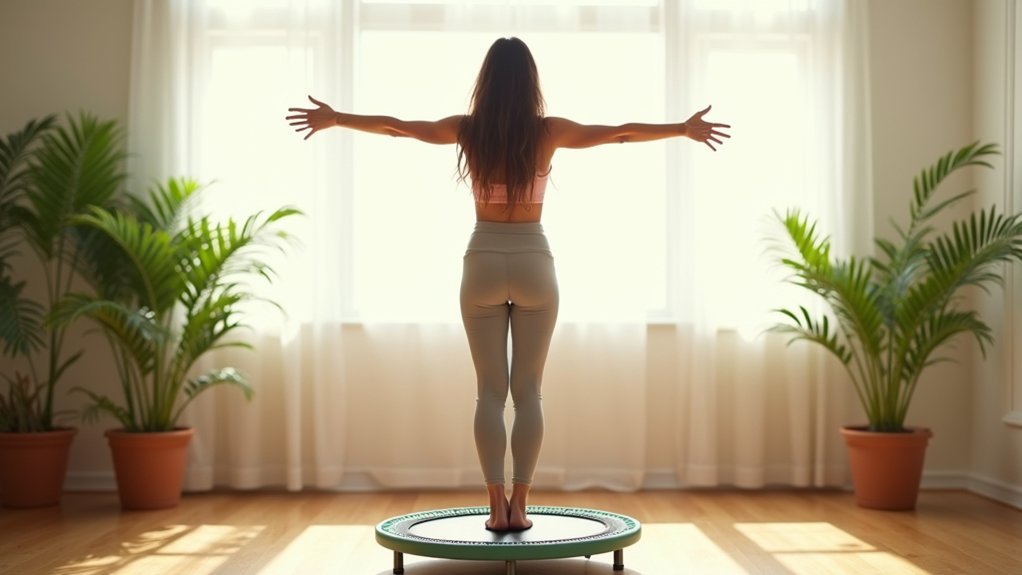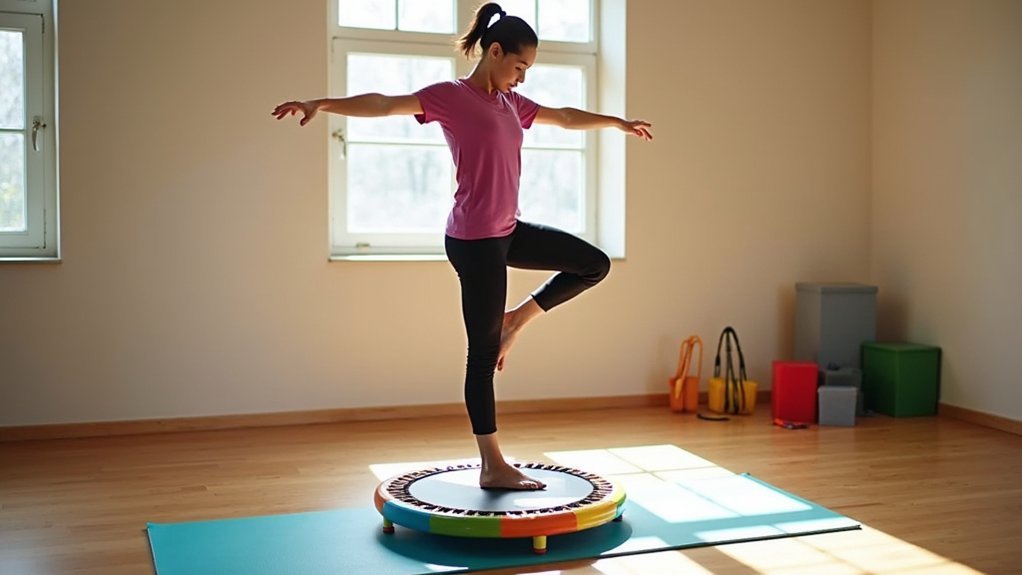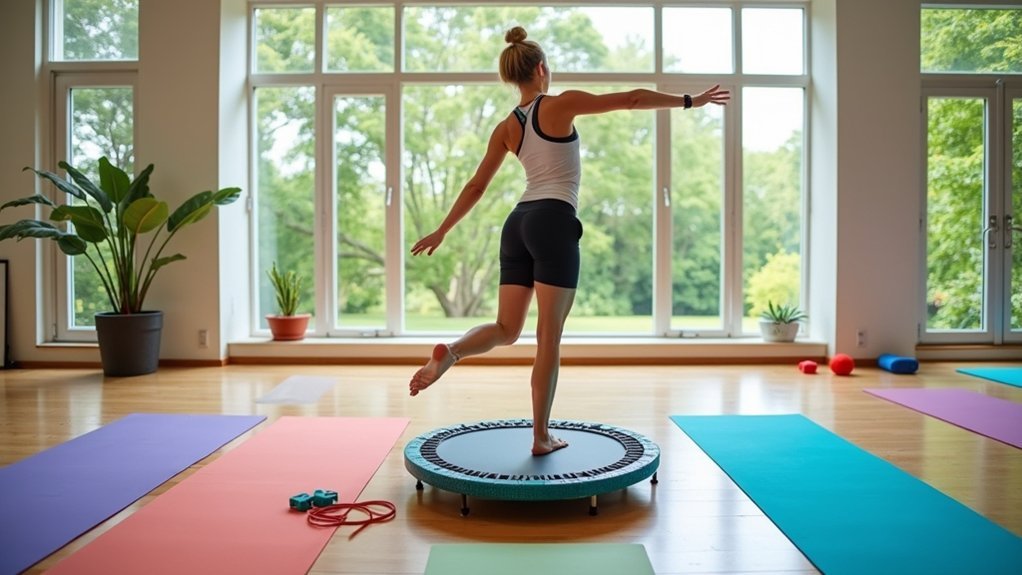Beginners can safely build balance on rebounders with gentle stand and bounce exercises, keeping feet shoulder-width apart while focusing on stability. Try simple weight shifting from side to side to engage your core and improve proprioception. Single-leg balances with support from handlebars offer a progressive challenge, while heel-to-toe stances develop stability. Start with just 1-2 minutes per exercise, always maintaining proper posture. These foundational movements open your path to advanced rebounding techniques.
The Basics of Rebounding for Balance Improvement

Five key elements make rebounding an effective balance training method.
First, the unstable surface of a rebounder naturally challenges your stability, forcing your body to make micro-adjustments.
The rebounder’s dynamic surface creates constant stability challenges, requiring continuous bodily adjustments to maintain balance.
Second, bouncing engages your core muscles, which are essential for maintaining balance in daily activities.
Third, simple movements like bouncing in place improve your proprioception—your body’s awareness of its position in space.
Fourth, the low-impact nature of rebounding allows you to safely practice balance exercises without stressing your joints.
Fifth, even basic exercises like side-to-side weight shifts enhance coordination between your brain and muscles.
When you’re first starting, focus on maintaining proper posture with your core engaged while performing gentle bounces.
Your balance will improve as these neural pathways strengthen through consistent practice.
Equipment Needed for Safe Balance Training on Rebounders
For safe balance training on your rebounder, you’ll need equipment with essential safety features like a spring cover or safety skirt to prevent injuries.
Consider adding stability enhancement tools such as detachable handlebars that provide extra support while you build confidence and master more challenging exercises.
Don’t forget proper athletic shoes with good traction to guarantee your feet remain firmly planted during balance movements, preventing slips that could lead to falls.
Essential Safety Features
Safety equipment transforms your rebounder exercises from potentially risky to confidently beneficial. When selecting a trampoline for balance training, look for one with a safety skirt covering springs like The Ness model. This vital feature protects you from pinch injuries while focusing on stability exercises.
For beginners, safety features that provide additional support are fundamental:
- Sturdy handlebars or T-shaped supports offer stability as you develop your balance skills.
- Bungee cord spring systems that absorb shock and reduce noise, protecting your joints during training.
- Non-slip surfaces that guarantee secure footing throughout your workout routine.
Don’t overlook proper footwear—it’s an extension of your rebounder’s safety system. The right shoes enhance grip and stability, letting you confidently progress through increasingly challenging balance exercises.
Stability Enhancement Tools
While the rebounder itself forms the foundation of your balance training, supplementary stability tools can dramatically improve both safety and exercise effectiveness.
As a beginner, you’ll benefit from adding a handlebar or T-shaped support to your setup, providing essential stability while you develop confidence in your balance exercises.
Don’t overlook the importance of a safety skirt covering the rebounder’s springs—this simple addition prevents accidents and lets you focus entirely on your movements.
Always wear non-slip footwear to maintain secure footing during your workout sessions.
For extra support when first starting out, position yoga blocks or mats around your rebounder.
These stability enhancement tools create a safety zone that allows you to progress at your own pace while developing proper technique and balance.
Gentle Stand and Bounce: Your First Balance Exercise

The simplest way to begin your rebounder balance journey is with the Gentle Stand and Bounce exercise.
Position your feet shoulder-width apart and start bouncing gently while keeping your upper body relaxed but stable. This foundational movement engages your core muscles, which are essential for maintaining balance on the trampoline.
As a beginner, you’ll want to:
- Start with low bounces for 5-10 minutes, allowing your legs to absorb the impact
- Focus on keeping your torso relatively still to improve proprioception
- Build confidence gradually before attempting more advanced exercises
This gentle exercise activates your lymphatic system while enhancing your body awareness.
You’ll notice improvements in your overall balance and stability as you practice consistently, creating a solid foundation for more challenging rebounder exercises.
Weight Shifting From Side to Side for Core Stability
Once you’ve mastered the gentle bounce, it’s time to add some lateral movement to your rebounder practice. Weight shifting from side to side is an excellent way to activate your core muscles while improving stability and balance.
Stand on your rebounder with your knees slightly bent and gradually transfer your weight between feet. This movement engages deep stabilizing muscles in your pelvis and spine, promoting better posture and reducing fall risk.
As one of the most effective balance exercises for beginners, side-to-side shifts challenge your proprioception and coordination.
Try practicing these weight shifts for 1-2 minutes to build muscle endurance in your core and lower body. With consistent practice, you’ll enhance your athletic performance across various activities, as core stability forms the foundation for all functional movements.
Heel-to-Toe Standing Progressions

Four simple words—heel touching toe—transform your rebounder routine into a powerful balance challenge. This heel-to-toe stance engages your core muscles while dramatically improving proprioception.
Start by holding the handlebar for stability, placing one foot directly in front of the other so your heel meets your toe. Maintain this position for 30-60 seconds, focusing on an upright posture.
- Begin with support – Hold the rebounder’s edge until your balance improves
- Progress gradually – Reduce support as your stability increases
- Add small bounces – Challenge yourself further by incorporating gentle bounces while maintaining the heel-to-toe position
As beginners master this exercise, you’ll notice improved coordination and reduced fall risk—making this progression particularly valuable for older adults new to rebounding.
Single-Leg Balance Holds for Beginners
Standing on one leg transforms a simple rebounder into a powerful tool for mastering balance. When you perform single-leg balance holds, you’ll engage your core muscles while improving proprioception—your body’s positional awareness.
Start by using the rebounder’s handlebar for support. Position yourself with a slight bend in your standing knee, keeping your core tight. Hold for 10-15 seconds initially, then gradually work up to 30 seconds as your stability improves.
Once you’re comfortable, challenge yourself by adding gentle bounces while maintaining your single-leg stance. This progression intensifies the workout by engaging additional muscle groups.
For beginners, these balance holds are particularly effective because the rebounder’s flexible surface creates natural instability, forcing your body to make constant micro-adjustments that enhance coordination.
Marching in Place With Controlled Movement
While beginners often focus on challenging exercises, marching in place offers a foundational skill that transforms your rebounder workout. This simple movement engages your core muscles while promoting stability through controlled movements, helping you develop essential balance skills.
Sometimes the simplest movements create the strongest foundation for rebounding success.
To perform this exercise effectively:
- Stand tall with feet shoulder-width apart on your rebounder, focusing on maintaining proper posture.
- Raise your knees alternately in slow, deliberate movements to build coordination.
- Add gentle arm swings to elevate your heart rate and enhance cardiovascular health benefits.
This low-impact exercise activates your lymphatic system, aiding in detoxification without stressing your joints.
Start with 1-2 minutes of marching in place to build confidence and endurance before advancing to more dynamic rebounding exercises.
Arm Extensions While Maintaining Balance
Begin your arm extension exercise by standing with feet hip-width apart on the rebounder, ensuring your core is engaged and your posture is tall.
You’ll progress from simple side extensions to more challenging overhead reaches and diagonal movements as your stability improves.
Watch for common challenges like shoulder elevation or torso leaning, which signal you need to slow down and refocus on your foundation of balance before advancing.
Starting Position Fundamentals
The three essential components of proper positioning on your rebounder begin with placing your feet shoulder-width apart. This starting position creates a stable foundation for your balance exercises.
Keep your knees slightly bent to absorb impact and maintain your center of gravity while engaging your core muscles for stability.
As you prepare for arm extensions, remember these key elements:
- Foundation – Your feet shoulder-width apart creates the base for all movements, allowing proper weight distribution across the rebounder surface.
- Engagement – A tight core connects your upper and lower body, preventing wobbling during controlled movements.
- Alignment – Maintaining straight posture with relaxed shoulders prevents strain while extending your arms forward or to the sides.
Practice this position for 1-2 minutes before adding more complex movements.
Progressive Arm Movements
Once you’ve mastered the starting position, adding arm extensions creates a new dimension to your rebounder workout.
These progressive arm movements actively engage your core muscles while challenging your balance on the unstable surface.
Start with small, controlled movements, extending your arms to the sides or overhead while maintaining stability. As your confidence grows, increase your range of motion gradually.
You’ll notice improvements in proprioception—your body’s ability to sense its position in space—which is essential for balance development.
Try various arm extension patterns: reach up, out to the sides, or alternate arms for different stability challenges.
These movements not only enhance your balance but also boost cardiovascular fitness as they elevate your heart rate while demanding precise muscle control throughout your rebounding session.
Common Stability Challenges
While progressing through arm extensions on your rebounder, you’ll encounter several common stability challenges that can test even experienced bouncers. As a beginner, you’ll need to focus on core stabilization while your upper body adjusts to the dynamic surface.
To overcome these stability challenges:
- Start with controlled arm extensions close to your body, gradually increasing range as your balance improves.
- Engage your core muscles consciously during each extension to maintain proper posture and prevent wobbling.
- Slow your bouncing pace initially, allowing your body to adapt to coordinating both the bounce and arm movements.
Remember that stability issues are normal and part of the learning process. Your proprioception will improve with practice, ultimately enhancing overall balance while maximizing the calorie-burning benefits of your rebounder workout.
Small Controlled Jumps for Proprioception
As you begin exploring balance training on rebounders, small controlled jumps offer an excellent foundation for developing proprioception. Keep a slight bend in your knees during each jump to enhance stability and reduce injury risk while maximizing muscle engagement.
Remember to activate your core with each movement—this engages essential stabilizing muscles that maintain your balance. Try adding variations like alternating feet or arm movements to challenge your coordination further.
| What You’ll Feel | What You’ll Gain |
|---|---|
| Heightened awareness | Reduced fall risk |
| Gentle challenge | Better daily stability |
| Core activation | Improved coordination |
| Muscle awakening | Enhanced mobility |
| Confidence building | Greater independence |
Regular practice of these small controlled jumps will strengthen your proprioception, making everyday movements more secure and reducing your risk of falls—especially valuable as you age.
Clock Face Reaches for Directional Stability
Clock Face Reaches improve your balance by teaching your body to maintain stability while moving in different directions, much like pointing to various numbers on a clock.
You’ll strengthen your proprioceptive awareness as you progress from reaching to nearby “hours” to extending farther for more challenging positions.
As you master this exercise, you’ll notice improved directional control that transfers to everyday movements, making you more stable in all your activities.
Precision Through Directional Awareness
When you’ve mastered basic stability on your rebounder, it’s time to enhance your balance with the Clock Face Reach exercise. This technique develops your spatial awareness as you extend arms and legs to mimic the positions on a clock face. Your core muscles engage to stabilize your body while you reach in different directions, improving your balance during rebounding workouts.
- Start with the basics – Practice reaching to 12, 3, 6, and 9 o’clock positions, maintaining steady body control throughout each movement.
- Progress gradually – Challenge yourself with diagonal reaches (1, 4, 7, and 10 o’clock) to further develop proprioception.
- Maintain consistency – Regular practice strengthens stabilizing muscles, ultimately reducing fall risk and enhancing dynamic coordination.
Incremental Difficulty Progression
To build meaningful balance skills on your rebounder, you’ll need a strategic approach to the Clock Face Reach exercise.
Begin by standing firmly and reaching toward 12 o’clock with one extended arm, engaging your core for stability.
As your confidence grows, progress to reaching at 3 and 9 o’clock positions using your opposite arm, which challenges proprioception.
Then incorporate 6 o’clock reaches by bending slightly forward, activating your back muscles for enhanced stability.
Ready for more difficulty? Add leg lifts while performing your reaches, balancing on one foot to dramatically increase core strength demands.
The final progression combines dynamic movements by shifting between reaches and gentle bounces, transforming balance exercises into effective cardio workouts.
This incremental difficulty approach guarantees continued improvement without overwhelming your developing balance skills.
Balance Recovery Techniques on Rebounders
Mastering balance recovery on a rebounder begins with understanding fundamental techniques that build stability while bouncing. Start with gentle bounces to engage your core muscles before progressing to weight shift jumps, where you’ll move side to side while maintaining a consistent bounce. These movements enhance your proprioception and balance control naturally.
- Practice single-leg balances by holding positions for 10-15 seconds on each leg to strengthen coordination and stability muscles.
- Incorporate arm movements like overhead reaches while bouncing to challenge your core stabilization and improve overall balance.
- Gradually introduce dynamic movements such as twist jumps or alternating foot placements to train your body to adjust to shifting weight distributions.
As you progress, you’ll notice improved balance both on and off the rebounder.
Progressive Challenges to Advance Your Balance Skills
As your comfort on the rebounder increases, you’ll need to incorporate increasingly difficult exercises to continue developing your balance capabilities. By gradually adding complexity to your routine, you’ll strengthen your core while enhancing coordination and stability.
| Difficulty | Exercise | Benefits |
|---|---|---|
| Beginner | Single-leg balances | Improves proprioception, builds ankle strength |
| Intermediate | Side-to-side shifts | Enhances lateral stability, challenges coordination |
| Advanced | Twist jumps | Develops rotational strength, tests multi-plane balance |
Start by mastering side-to-side weight transfers before progressing to dynamic movements like knee lifts or kickbacks. These exercises require greater core engagement and balance control. When you’re ready for a greater challenge, add rotational elements to your bouncing routine, which will greatly improve your overall stability and rebounder strength.
Incorporating Balance Exercises Into Your Regular Rebounding Routine
While many rebounding enthusiasts focus solely on cardiovascular benefits, integrating dedicated balance exercises into your routine can dramatically improve your stability and coordination.
You’ll engage core muscles more effectively by adding simple balance challenges to your existing rebounding sessions without needing separate workout time.
- Begin each session with 2-3 minutes of gentle bouncing while alternating standing on one leg to activate stabilizing muscles and improve balance.
- Between cardio intervals, add 30-second segments of side-to-side weight shifts to enhance coordination and strengthen lower body stability.
- Cool down with toe taps or heel raises while softly bouncing to strengthen ankles and reinforce balance skills.
As you progress, try closing your eyes during simple balance exercises to further challenge your proprioception and stability.
Frequently Asked Questions
Does Rebounding Improve Balance?
Yes, rebounding improves your balance considerably. When you bounce, you’re engaging core muscles and stabilizers that control your posture. The unstable surface forces you to constantly adjust, enhancing your proprioception and stability skills.
What Is 10 Minutes on a Rebounder Equivalent To?
Ten minutes on a rebounder is equivalent to running at 6 mph or biking at 14 mph. You’ll burn about 94 calories (for women) while enjoying cardiovascular benefits similar to moderate-intensity aerobic exercise.
How Long Should I Rebound as a Beginner?
As a beginner, you’ll want to start with 10-minute rebounding sessions, 3-4 times weekly. Listen to your body and gradually increase your time to 30 minutes as your strength and confidence improve.
What Is the Downside of Rebounding?
Rebounding can worsen inner ear issues, may be risky during pregnancy, and isn’t suitable for those with joint replacements without medical clearance. You’ll risk injury if you don’t engage your core properly or overexert yourself.
In Summary
By starting with these simple balance exercises on your rebounder, you’ll build a solid foundation for more advanced moves later. Remember to progress at your own pace and don’t rush the process. Even just a few minutes of balance work 2-3 times weekly will greatly improve your stability, coordination, and confidence. Stick with it—you’ll be amazed at how quickly your balance transforms!





Leave a Reply